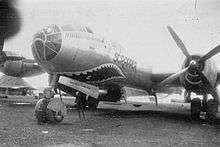869th Bombardment Squadron
869th Bombardment Squadron
.png) | |
|---|---|
|
Crew of 869th B-29 42-24598 "Waddy's Wagon" (lost 9 January 1945) | |
| Active | 1943–1946 |
| Country |
|
| Branch | United States Army Air Forces |
| Role | Bombardment |
| Engagements | Pacific Theater of Operations |
| Decorations | Distinguished Unit Citation |
| Insignia | |
| 869th Bombardment Squadron Emblem (approved 10 May 1944)[1] |
 |
The 869th Bombardment Squadron is an inactive United States Air Force unit. Its last assignment was with 497th Bombardment Group at MacDill Field, Florida where it was inactivated on 31 March 1946. The squadron served in combat with Twentieth Air Force flying Boeing B-29 Superfortress aircraft in the Pacific Theater of Operations during World War II, where it earned two Distinguished Unit Citations.
History

The squadron was established in late 1943 as the 869th Bombardment Squadron at El Paso Army Air Base, Texas, a Boeing B-29 Superfortress very heavy bombardment squadron that was one of the original operational squadrons of the 497th Bombardment Group.[1] The squadron's initial cadre was drawn from the 491st Bombardment Group.[2]
In December the squadron moved on paper to Clovis Army Air Field, New Mexico.[2] At Clovis, the squadron began to man its air echelon by January 1944. The 869th drew heavily on aircrews of the 480th Antisubmarine Group who were returning to the United States from duty in England and Africa to fill out its crews. Aircrew training at Clovis was limited to ground training, although some flying in Boeing B-17 Flying Fortress and Consolidated B-24 Liberator aircraft assigned to the 73d Bombardment Wing was accomplished. Key personnel trained with the Army Air Forces School of Applied Tactics at Orlando Army Air Base, Florida.[3]
In April 1944, the air and ground echelons united at Pratt AAF. Here the 869th finally received newly manufactured Boeing B-29 Superfortresses the following month, although it continued to fly B-17s due to continuing engine problems with the B-29s. In May the United States Army Air Forces reorganized its very heavy bombardment units. The 872d Bombardment Squadron and support units of the 497th group were inactivated and their personnel absorbed into the 869th and the remaining squadrons of the group.[4]

The 869th deployed to the Pacific Theater of Operations, with the ground echelon sailing 30 July on the SS Fairisle, passing through Honolulu and Eniwetok before arriving at Saipan on 20 September.[5] Upon arrival the squadron's personnel were engaged in construction. By mid-October most personnel were able to move into Quonset huts from the tents that they were assigned on their arrival. The aircrews began departing from Kansas on 6 October, ferrying their aircraft to Saipan via a 6500 nautical mile route, with the last B-29 arriving on 30 October. At Saipan the unit became part of the XXI Bomber Command[1] at Isely Field.

The squadron began operations on 28 October 1944 with a night attack against the submarine pens at Truk Islands and attacks against Iwo Jima in early November.[6] The squadron took part in the first attack on Japan by AAF planes based in the Marianas.[7] On 24 November 1944 Major Robert Morgan, the squadron commander, led the first mission of the XXI Bomber Command to bomb Japan, with wing commander Brigadier Gen. Emmett O'Donnell, Jr. as co-pilot. 110 aircraft of the 73rd Bombardment Wing bombed Tokyo during this mission. Major Morgan and his crew had flown a solo mission on 10 November using radio countermeasures equipment to obtain information on the disposition of Japanese early warning and gun control radars.[8] The 869th flew missions against strategic objectives in Japan, originally in daylight and from high altitude.[7] It was also tasked with "Weather Strike" missions which were single ship flights flown nightly to obtain weather information for target areas in Japan whilst making incendiary attacks on various targets.[9]
The squadron received a Distinguished Unit Citation (DUC) for a mission on 27 January 1945. Although weather conditions prevented the group from bombing its primary objective, the unescorted B-29’s withstood severe enemy attacks to strike an alternate target, the industrial area of Hamamatsu. It was awarded a second DUC for attacking strategic centers in Japan during July and August 1945. The squadron assisted the assault on Okinawa in April 1945 by bombing enemy airfields to reduce air attacks against the invasion force. Beginning on 19 March and continuing until the end of the war, the squadron ran incendiary raids against Japan, flying at night and at low altitude to bomb area targets.[7] The unit released propaganda leaflets over the Japanese home islands,[10] continuing strategic bombing raids and incendiary attacks until the Japanese surrender in August 1945.[7]
After V-J Day, the 869th dropped supplies to Allied prisoners.[11] In November 1945 the unit returned to the United States[1] where it was initially assigned to Continental Air Forces's (CAF) Fourth Air Force at March Field, California. In January 1945, the 869th became part of Third Air Force at MacDill Field, Florida. In March 1946 CAF became Strategic Air Command (SAC), and the squadron was one of SAC's first bombardment squadrons. Demobilization, however, was in full swing and the squadron turned in its aircraft and was inactivated on 31 March.
Lineage
- Constituted as the 869th Bombardment Squadron, Very Heavy on 19 November 1943
- Activated on 20 November 1943
- Inactivated on 31 March 1946
Assignments
- 497th Bombardment Group: 20 November 1943 - 31 March 1946
Stations
|
|
Awards and Campaigns
| Award streamer | Award | Dates | Notes |
|---|---|---|---|
| Distinguished Unit Citation | 27 January 1945 | Japan[1] | |
| Distinguished Unit Citation | 26 July 1945 - 2 August 1945 | Japan[1] |
Manual campaign table
| Campaign Streamer | Campaign | Dates | Notes |
|---|---|---|---|
| Air Offensive, Japan | [1] | ||
| Eastern Mandates | [1] | ||
| Western Pacific | [1] |
Aircraft
- Boeing B-17 Flying Fortress, 1944
- Boeing B-29 Superfortress, 1944–1946
References
Notes
- 1 2 3 4 5 6 7 8 9 Maurer, Combat Squadrons, pp. 790–791
- 1 2 Stewart etal., p. 26
- ↑ Stewart et al., pp. 27–30
- ↑ Stewart et al., pp. 38–40
- ↑ Stewart et al., pp. 46, 58
- ↑ Stewart et al., pp. 68, 77
- 1 2 3 4 Maurer, Combat Units, p. 364
- ↑ Stewart et al., pp. 77–80
- ↑ Stewart et al., p. 91
- ↑ Stewart et al., p. 113
- ↑ Stewart et al., p. 132
Bibliography
-
 This article incorporates public domain material from the Air Force Historical Research Agency website http://www.afhra.af.mil/.
This article incorporates public domain material from the Air Force Historical Research Agency website http://www.afhra.af.mil/. - Maurer, Maurer, ed. (1983) [1961]. Air Force Combat Units of World War II (PDF) (reprint ed.). Washington, DC: Office of Air Force History. ISBN 0-912799-02-1. LCCN 61060979.
- Maurer, Maurer, ed. (1982) [1969]. Combat Squadrons of the Air Force, World War II (PDF) (reprint ed.). Washington, DC: Office of Air Force History. ISBN 0-405-12194-6. LCCN 70605402. OCLC 72556.
- Stewart, Harry A.; Power, John E. (1947). Goforth, Pat E., ed. The Long Haul: The Story of the 497th Bomb Group (VH). Bangor Public Library World War Regimental Histories. San Angelo, TX: Newsfoto Publishing Co. Retrieved August 18, 2013.
_-_NARA_-_292576.jpg)